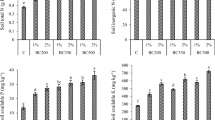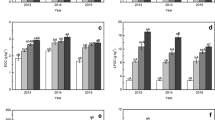Abstract
Purpose
Humic substances, which are integral components of total organic carbon (TOC), influence soil quality. The study aimed to investigate whether humic and non-humic fractions exhibit early, consistent, and measurable changes and affect TOC sensitivity and storage in a tropical sandy loam soils amended with corn cob biochar.
Materials and methods
There were four treatments with four replicates established in a randomized complete block design. Composite soil samples were taken from plots without biochar (CT), from plots incorporated with 15 t biochar ha−1 (BC-15), and 30 t biochar ha−1 without or with phosphate fertilizer (BC-30 and BC-30+P). The TOC, and humin, humic acid (HA), and fulvic acid (HA) fractions of soil organic carbon were determined for each treatment. The optical densities (400–700 nm) were measured on the soil-free extracts by spectrophotometry; the densities measured at 465 and 665 nm were used to calculate the E465/E665 ratios.
Results and discussion
The BC-30 and BC-30+P plots recorded the highest TOC, humin, humic acid (HA), and fulvic acid (FA) contents with respect to the lowest in the CT. The total exchangeable carbon stratification was significantly higher in all the biochar-treated plots relative to the CT. Spectral analysis showed higher values of E465/E665 (5.02 and 5.15) in the CT and BC-15-treated soils, respectively, compared with the BC-30 and BC-30+P-amended soils with E465/E665 ratios of 2.76 and 2.98, respectively.
Conclusions
Corn cob biochar applied to a tropical sandy loam:
• increased the concentrations of HA and FA and led to increased stratification of TOC, with a stronger effect on HA compared with FA;
• significantly lowered E465/E665 at the high biochar application rate of 30 t ha−1, implying the dominance of high molecular weight humic acid-like substances, and increased degree of aromaticity of the TOC.



Similar content being viewed by others
References
Amoakwah E, Frimpong KA, Arthur E (2017a) Corn cob biochar improves aggregate characteristics of a tropical sandy loam. Soil Sci Soc Am J 81:1054–1063
Amoakwah E, Frimpong KA, Okae-Anti D, Arthur E (2017b) Soil water retention, air flow and pore structure characteristics after corn cob biochar application to a tropical sandy loam. Geoderma 307:189–197
Aziz I, Mahmood T, Islam KR (2013) Effect of long term no-till and conventional tillage practices on soil quality. Soil Tillage Res 131:28–35
Aziz, MT, Islam, KR (2014) Impact of sole cropping and multiple cropping on soil humified carbon fractions. Pak J Bot 2157–2162
Balesdent J, Chenu C, Balabane M (2000) Relationship of soil organic matter dynamics to physical protection and tillage. Soil Tillage Res 53:215–230
Bayer C, Mielniczuk J, Martin-Neto L, Ernani PR (2002) Stocks and humification degree of organic matter fractions as affected by no-tillage on a subtropical soil. Plant Soil 238:133–140
Brink RHJr, Dubach P, Lynch DL (1960) Measurement of carbohydrates in soil hydrolyzates with anthrone. Soil Science 89:157–166
Chen Y, Senesi N, Schnitzer M (1977) Information provided on humic substances by E4/E6 ratios1. Soil Sci Soc Am 41:352–358
Daoyuan W, Fonte SJ, Parikh SJ et al (2017) Biochar additions can enhance soil structure and the physical stabilization of C in aggregates. Geoderma 303:110–117
Doane TA, Devevre OC, Horwarth WR (2003) Short term oil carbon dynamics of humic fractions in low-input and organic cropping systems. Geoderma 319–331 doi: https://doi.org/10.1016/S0016-7061(03)00047-8
Domingues RR, Trugilho PF, Silva CA, Melo ICNA, Melo LCA, Magriotis ZM, Sánchez-Monedero MA (2017) Properties of biochar derived from wood and high-nutrient biomasses with the aim of agronomic and environmental benefits. PLoS One 12:e0176884. https://doi.org/10.1371/journal.pone.0176884
Don A, Schumacher J, Freibauer A (2011) Impact of tropical land-use change on soil organic carbon stocks – a meta-analysis. Glob Change Biol 17:1658–1670
Fernández-Ugalde O, Gartzia-Bengoetxea N, Arostegi J et al (2017) Storage and stability of biochar-derived carbon and total organic carbon in relation to minerals in an acid forest soil of the Spanish Atlantic area. Sci Total Environ 587:204–213
Flaig W, Beutelspacher H, Rietz E (1975) Chemical composition and physical properties of humic substances. In: Gieseking JE (ed) Soil Components: Vol. 1: Organic components. Springer Berlin Heidelberg, pp 1–211
Franzluebbers AJ (2002) Soil organic matter stratification ratio as an indicator of soil quality. Soil Tillage Res 66:95–106
Ghosh K, Schnitzer M (1979) UV and visible absorption spectroscopic investigations in relation to macromolecular characteristics of humic substances. Soil Sci 30:735–745
Hairani A, Osaki M, Watanabe T (2016) Effect of biochar application on mineral and microbial properties of soils growing different plant species. Soil Sci and Plant Nutr 62:519–525
Hartley W, Riby P, Waterson J (2016) Effects of three different biochars on aggregate stability, organic carbon mobility and micronutrient bioavailability. Environ Manag 181:770–778
Hayes MHB (1989) Humic substances II. In search of soil structure. Wiley, Chichester
Islam KR, Kamaluddin M, Bhuiyan MK, Badruddin A (1999) Comparative performance of exotic and indigenous forest species for tropical semievergreen degraded forest land reforestation in Chittagong, Bangladesh. Land Degrad Dev 10:241–249. https://doi.org/10.1002/(SICI)1099-145X(199905/06)10:3<241::AID-LDR335>3.0.CO;2-8
Islam KR, Mulchi CL, Ali AA (2000) Interactions of tropospheric CO2 and O3 enrichments and moisture variations on microbial biomass and respiration in soil. Glob Change Biol 6:255–265
Islam KR, Weil RR (2000) Land use effects on soil quality in a tropical forest ecosystem of Bangladesh. Agri Ecosyst Environ 79:9–16
IUSS Working Group WRB (2015) World reference base for soil resources 2014 (update 2015), international soil classification system for naming soils and creating legends for soil maps. World Soil Resiurces Reports no. 106, FAO, Rome
Khan A (1959) Studies on the size and shape of clay particles in aqueous suspension. Clay Clay Miner 6:220–236
Larson, WE, Pierce, FJ (1991) Conservation and enhancement of soil quality. In: Evaluation for sustainable land management in the developing world. In: IBSRAM Proceedings. Bangkok, Thailand
Li Q, Tian Y, Zhang X et al (2017) Labile carbon and nitrogen additions affect soil organic matter decomposition more strongly than temperature. Appl Soil Ecol 114:152–160
Liu Z, Dugan B, Masiello CA, Gonnermann HM (2017) Biochar particle size, shape, and porosity act together to influence soil water properties. PLoS One 12:e0179079. https://doi.org/10.1371/journal.pone.0179079
Milori DMBP, Martin-Neto L, Bayer C, Mielniczuk J (2002) Humification degree of soil humic acids determined by fluorescence spectroscopy. Soil Sci 167:739–749
Navarrete IA, Tsutsuki K, Navarrete RA (2011) Humus composition and the structural characteristics of humic substances in soils under different land uses in Leyte, Philippines. J. Soil Sci Plant Nutr 56:289–296
Rodríguez-Vila A, Asensio V, Forján R, Covelo EF (2016) Carbon fractionation in a mine soil amended with compost and biochar and vegetated with Brassica juncea L. J Geochem Explor 169:137–143
Salinas-Garcia JR, Hons FM, Matocha JE, Zuberer DA (1997) Soil carbon dynamics as affected by long-term tillage and ganic matter in mineral soils. Biol Fert Soils 25:182–188
Saviozzi A, Levi-Minzi R, Riffaldi R (1994) The effect of forty years of continuous corn cropping on soil organic matter characteristics. Plant Soil 160:139–145
Schnitzer M (2000) A lifetime perspective on the chemistry of soil organic matter. In: Sparks DL (ed) Academic Press, pp 1–58
Stevenson FJ (1994) Humus chemistry: genesis, composition, and reactions. Wiley, New York
Wang ZY, Chen L, Sun FL et al (2017) Effects of adding biochar on the properties and nitrogen bioavailability of an acidic soil. Eur J Soil Sci 68:559–572
Yavitt JB, Fahey TJ (1985) Organic chemistry of the soil solution during snowmelt leaching in Pinus contorta forest ecosystems, Wyoming, USA. In: Planetary ecology. Van Nostrand Reinhold, New York, pp 485–496
Yousaf B, Liu G, Wang R et al (2017) Investigating the biochar effects on C-mineralization and sequestration of carbon in soil compared with conventional amendments using the stable isotope (δ13C) approach. Glob Change Biol 9:1085–1099
Yu OY, Harper M, Hoepfl M, Domermuth D (2017) Characterization of biochar and its effects on the water holding capacity of loamy sand soil: comparison of hemlock biochar and switchblade grass biochar characteristics. Environ Prog Sustain Energy 36:1474–1479
Zalba P, Quiroga AR (1999) Fulvic acid carbon as a diagnostic feature for agricultural soil evaluation. Soil Sci 164:
Zech W, Senesi N, Guggenberger G et al (1997) Factors controlling humification and mineralization of soil organic matter in the tropics. Geoderma 79:117–161. https://doi.org/10.1016/S0016-7061(97)00040-2
Zhang M, Cheng G, Feng H, Sun B, Zhao Y, Chen H, Chen J, Dyck M, Wang X, Zhang J, Zhang A (2017) Effects of straw and biochar amendments on aggregate stability, soil organic carbon, and enzyme activities in the Loess Plateau. Environ Sci Pollut Res 24:10108–10120
Zhao S, Ta N, Li Z et al (2018) Varying pyrolysis temperature impacts application effects of biochar on soil labile organic carbon and humic fractions. Appl Soil Ecol 123:484–493
Acknowledgments
This work was supported by Danida (Ministry of Foreign Affairs of Denmark) under the project “Green Cohesive Agricultural Resource Management, WEBSOC,” DFC project no: 13-01AU, and the Borlaug Leadership Enhancement in Agriculture Program (Borlaug LEAP) through a grant to the University of California-Davis by the United States Agency for International Development.
Data availability statement
The data that support the findings of this study are available from the corresponding author upon reasonable request.
Author information
Authors and Affiliations
Corresponding author
Additional information
Responsible editor: Hailong Wang
Publisher’s note
Springer Nature remains neutral with regard to jurisdictional claims in published maps and institutional affiliations.
Rights and permissions
About this article
Cite this article
Amoakwah, E., Arthur, E., Frimpong, K.A. et al. Soil organic carbon storage and quality are impacted by corn cob biochar application on a tropical sandy loam. J Soils Sediments 20, 1960–1969 (2020). https://doi.org/10.1007/s11368-019-02547-5
Received:
Accepted:
Published:
Issue Date:
DOI: https://doi.org/10.1007/s11368-019-02547-5




